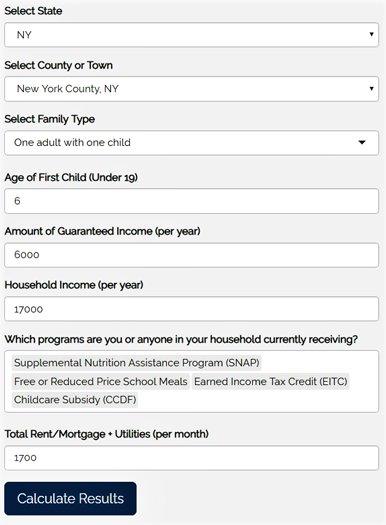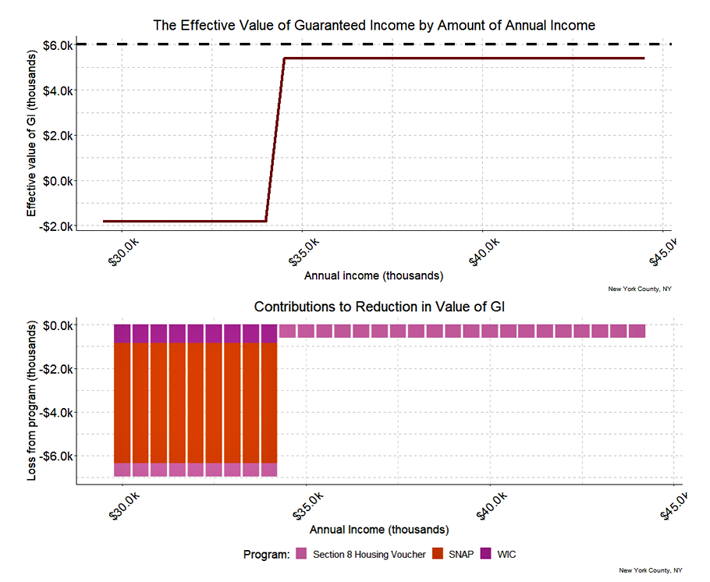
Guaranteed Income (GI) pilot programs are designed to increase financial stability by providing families with unconditional periodic cash transfers for a set amount of time to a specific target population (such as low-income mothers, immigrant families, or youth experiencing housing instability). When creating a GI pilot program, a key concern is how GI interacts with existing social safety net programs. The Atlanta Fed's Advancing Careers initiative has been working with GI pilot programs across the nation to help them analyze the extent to which the receipt of GI will affect families' overall financial resources. In particular, we developed an interactive tool called the GI Dashboard that calculates the effect of GI on a family's public assistance receipt, given a household's location, composition (like the number and ages of children), current participation in benefit programs and tax credits, and household level expenses for housing and childcare.1 Partners Update summarizes the rationale behind GI pilot programs and how the GI Dashboard can assist practitioners, policymakers, and GI recipients.
Background
The negative economic impact of COVID-19 on low- and moderate-income families—together with long-standing concerns about rising poverty, economic inequality, and gaps in the social safety net—have increased attention to programs that provide household financial stability. As a result, a growing number of guaranteed income pilot programs are being implemented across the United States. The Mayors for a Guaranteed Income coalition lists over 50 participating mayors, as well as ongoing pilot programs in cities such as Compton and Stockton, California; St. Paul, Minnesota; Richmond, Virginia; Chelsea, Massachusetts; Paterson, New Jersey; Hudson, New York; and Gary, Indiana. Legislation has been introduced at the federal level to create GI pilot programs and a permanent GI program, while New York has introduced legislation and Illinois has enacted a law to exempt GI support provided to pilot program participants when determining eligibility for other public assistance programs. In July 2021, California became the first state to enact a state-funded guaranteed income pilot program. The design of GI pilot programs is fundamentally different from the existing social safety in several ways.
See demo versions of the GI Dashboard.
Guaranteed income is not conditional on eligibility determinations such as income levels or work requirements. Once in a GI pilot, participants unconditionally receive payments for the duration of the program, typically monthly for one or two years. Families can also spend the money on any goods and services, rather than on specified items such as food or childcare. Most social safety net programs, in contrast, require participants to maintain their income and assets below a certain threshold, and many come with work requirements (Ilin and Terry, 2021). Proponents of GI argue that such requirements limit the effectiveness of the safety net by making it procedurally difficult and time-consuming to apply for assistance, causing stigma for those who enroll in programs and creating income volatility when individuals unexpectedly lose public assistance. Furthermore, requirements of social safety net programs may reduce their responsiveness to economic downturns (see also Mofitt and Ziliak, 2020).
Because many safety net programs are means-tested and phase out as income increases, counting GI as income may trigger a partial or complete loss of a family's public assistance receipt. If the GI program leads to a reduction in the dollar value of means-tested programs such as public health care or food assistance, it may be less effective in achieving the goal of improving family financial stability. For example, researchers have documented how GI can reduce food assistance, housing subsidies, and disability benefits. The loss of the financial resources from these programs can reduce the effective value of GI for families. This loss can also lead families to decline to participate in GI programs.2
The GI Dashboard's primary use case is to help prospective participants make an informed decision about whether they would like to participate in the program. According to Megha Agarwal, executive director of the Monarch Foundation and funder and implementer of The Bridge Project GI pilot in New York City,
"The calculator was extremely helpful for our onboarding process and essentially the only way that we were able to give our mothers any insight into the impact our program may have on their public benefits. It easily allowed them to understand where they could expect to lose consistent financial government support, and it gave them the ability to weigh for themselves the pros and cons of what that meant for their individual situations. We wouldn't have felt comfortable onboarding mothers into our program without providing this sort of transparency and information."
In addition to providing participants with valuable information, the GI Dashboard has two important policy-related use cases. First, GI pilot programs are using the GI Dashboard to understand the extent to which guaranteed income payments affect the dollar value of different public assistance programs. Whether or not GI is counted toward income eligibility varies across public assistance programs. Thus, depending on the program, GI may reduce or have no effect on the amount of public assistance received. This analysis helps GI administrators inform state and federal policymakers about the potential need for waivers that disregard income received in GI pilot programs when determining eligibility for other public assistance programs.
Second, GI Dashboards can be used by pilot programs to inform program design, such as how and when to distribute payments to participants. GI provided as a large single payment, compared to GI spread out over several years, has different implications for public assistance loss. For example, the receipt of $12,000 in one month could result in a total loss of childcare assistance if it puts a family over the income eligibility threshold in their state. In contrast, the receipt of $500 per month spread over two years is more likely to result in only a small increase in a family's copay at childcare centers.3 The GI Dashboard can also inform program design by assessing variation in public assistance loss across participants. It also can be used for designing mitigation strategies such as "hold harmless" funds that compensate participating families for losses in public assistance due to GI.
In order to determine the interaction between GI and the social safety net, the GI Dashboard uses the Atlanta Fed's Policy Rules Database, or PRD (Ilin and Terry, 2021). The PRD is an open-source repository that contains up-to-date program rules and provisions for all major federal and state public assistance programs, tax provisions, and tax credits in a single easy-to-use database. For information on the PRD, see this Atlanta Fed Partners Update article.
Example using a mother in New York City
We demonstrate the utility of the GI Dashboard by using a customized tool we built for a GI pilot in the Harlem and Washington Heights neighborhoods of New York City. The pilot program offered $500 or $1,000 per month of guaranteed income for three years to low-income mothers. Figure 1 shows how we input the information into the GI Dashboard to analyze how the guaranteed income affects the financial resources of a single mother with one child (age six) living in New York, New York. In this example, we assume that the mother receives Supplemental Nutrition Assistance Program (SNAP), Free or Reduced Price School Meals, a Child Care Subsidy (CCDF)4, and the Earned Income Tax Credit (EITC). She has a $17,000 annual income, which is just below 100 percent of the federal poverty level (FPL) for a family of two, and she pays $1,700 per month for rent and utilities. Her childcare expenses, before taking into account reductions due to the CCDF subsidy, are assumed to be $465 per month.
Figure 1: The GI Dashboard Inputs

After the user inputs this information, the GI Dashboard calculates the estimated yearly value of each public assistance program that the mother receives in the absence of the GI.5 This information can be used to confirm with the family that the GI Dashboard's initial calculations are correct and to provide a baseline value to contextualize potential losses due to GI. In addition to the baseline estimates, the GI Dashboard shows the amount of public assistance the mother would potentially lose if she chooses to accept the GI.
The GI Dashboard output is shown in table 1. The first column in the table lists the program or tax credit, the second shows the baseline public assistance amount without GI, and the third lists the change due to GI. In this example, the GI Dashboard shows that GI reduces the estimated value of the mother's childcare subsidy by $600 per year (reflecting an increase in daycare copays). The value of SNAP received would decline $1,260 and the value of free or reduced-price school meals would fall $126. The value of the EITCs would not decline. Thus, the additional $6,000 in GI triggers a reduction in the family's public assistance income of $1,986, resulting in a net gain of $4,014—33 percent less than the GI amount.
Table 1: First Example of the Effect of Guaranteed Income on Government Assistance Programs and Tax Credits

Note: Rent is assumed to be $1,700 per month and childcare expenses are assumed to be $465 per month.
The effect of GI on public assistance will vary depending on the family's income level, composition, and the types of public assistance that mothers in the program are receiving. To illustrate these differences, table 2 shows how the same GI program would affect a single parent with a four-year-old that receives SNAP, the Nutrition Program for Women, Infants, and Children (WIC), EITC, and the Section 8 Housing Voucher program. The mother's income of $34,000 is twice that of the first example and just below 200 percent of the FPL for the family of two. In this example, the extra income from the GI program puts the mother over the income eligibility thresholds for both SNAP and WIC, leading to the total loss of both subsidies. Due to the design of the Section 8 Housing Voucher, the mother also would pay about $600 more per year toward her total rent due to the extra GI income. Overall, the loss of public assistance as a result of the GI would make the family financially worse off. The effective value of the guaranteed income for this family is -$1,812.
Table 2: Second Example of the Effect of Guaranteed Income on Government Assistance Programs and Tax Credits

Note: Rent is assumed to be $1,700 per month and childcare expenses are assumed to be $1,000 per month.
In addition to the two tables, the GI Dashboard provides two supplemental charts showing how the loss of public assistance varies across a range of income for the selected family type. These two charts (shown in figure 2 for the second example with a four-year-old) are useful in the case that the mother reports that her income varies or for policymakers that want to understand the effect of GI across a range of incomes. The top chart in figure 2 ("The Effective Value of Guaranteed Income by Amount of Annual Income") shows that with income between $29,500 and $34,000, the effective value of a $500 per month guaranteed income is -$1,812. If the mother's income were slightly higher—between $34,500 and $43,500—the effective value of a $500 per month guaranteed income is $5,400. The bottom chart in figure 2 ("Contributions to Reduction in Value of GI") shows the incremental loss of each public assistance program by income. If a household's income is between $29,500 and $34,000 per year, the value of Section 8 Housing Voucher, SNAP, and WIC all decline if GI is received. If the household has between $34,500 and $43,500 per year, only the Section 8 Housing Voucher benefit declines (-$600) if GI is received.
Figure 2: Supplemental Charts in the GI Dashboard

Note: Assumes a family of one adult and one child aged four living in New York City.
Conclusion
The mission of the Atlanta Fed's Advancing Careers Initiative is to conduct research on benefits cliffs, develop tools to support community and state efforts to improve economic security for families, and meet the talent needs of businesses for a healthy economy. As part of this initiative, the Guaranteed Income Dashboard is customized to the needs of local GI pilot programs to support the program design, determine the need for waivers or other mechanisms to reduce the impact of public assistance loss, and inform families about the benefits and risks of participating in a GI program. In addition to the GI pilot program in New York City, we have made GI Dashboards for upcoming GI pilot programs in Austin, Texas; Atlanta, Georgia; and Tacoma, Washington. Visit our partnership page to read about each pilot program and see their dashboards.
By Elias Ilin, Atlanta Fed research associate and a PhD candidate at Boston University, Alexander Ruder, principal CED adviser, and Ellyn Terry, Atlanta Fed research associate and a PhD student at the University of Washington. Ilin, Ruder, and Terry are with the Atlanta Fed's Advancing Careers Initiative. The views expressed here are the authors' and not necessarily those of the Federal Reserve Bank of Atlanta or the Federal Reserve System. Any remaining errors are the authors' responsibility.
References
"An Act to Amend the Social Services Law, in Relation to Exempting Certain Income and Resources Provided to Persons Enrolled in Certain Pilot Programs with Direct Cash Transfers in Determining Eligibility for Public Assistance Benefits; and Providing for the Repeal of Such Provisions upon Expiration thereof." 2021. New York State Senate S5759B.
"An Act Concerning Public Aid." 2019. Illinois Public Act 101-0145.
Beam, Adam. July 15, 2021. "California Approves 1st State-funded Guaranteed Income Plan." Associated Press News.
Drexel University Center for Hunger-Free Communities. February 2021. "Universal Basic Income: Key to Reducing Food Insecurity and Improving Health." Policy Brief.
Federal Reserve Community Development Staff. October 12, 2021. "Perspectives from Main Street: COVID-19's Continued Impact on Low- to Moderate-Income Communities." Fed Communities.
Guaranteed Income Community of Practice. June 2021. "The Benefits Cliff and Guaranteed Income: Strategies to Mitigate the Loss of Benefits during Participation in Guaranteed Income Pilot Programs while Strengthening the Social Safety Net."
"Guaranteed Income Pilot Program Act of 2021." 2021. 117th Congress. H.R. 4342.
Ilin, Elias, and Ellyn Terry. 2021. "Policy Rules Database."
Ilin, Elias, and Ellyn Terry. August 2021. "Policy Rules Database: Visualizing the US Social Safety Net." Federal Reserve Bank of Atlanta Partners Update.
Mayors for a Guaranteed Income. 2021. "Year in Review: June 2020–June 2021."
Moffitt, Robert A., and James P. Ziliak. 2020. "COVID-19 and the U.S. Safety Net." Fiscal Studies 41(3): 515–548.
_______________________________________
1 The GI Dashboard assumes the GI is structured as a gift according to IRS guidelines. Alternative payment structures may have different impacts on public assistance. Household level housing and childcare expenses are included as deductions in the eligibility determinations for some programs.
2 For example, families in one GI pilot dropped out of the program for fear of losing disability benefits, which are valuable for families and administratively difficult to obtain. The perceived risk of not being able to get back on disability benefits outweighed the benefits of enrolling in the GI program.
3 States have different rules regarding how often participants need to recertify to remain eligible and how quickly participants need to report changes in earnings. Both of these factors would affect the timing of the loss of the childcare subsidy.
4 Each state has a childcare subsidy program funded by a block grant called the Child Care and Development Fund (CCDF) grant.
5 The first step of using the Dashboard with prospective participants is to confirm the values displayed match what the person is currently receiving. As part of the Dashboard's implementation evaluation, we asked users in one pilot about the accuracy of the results. In the pilot, four counselors served over 100 families with the Dashboard. Three counselors report the values shown are either always or most of the time within $100 of the amounts the person is actually receiving. One counselor responded "sometimes."


